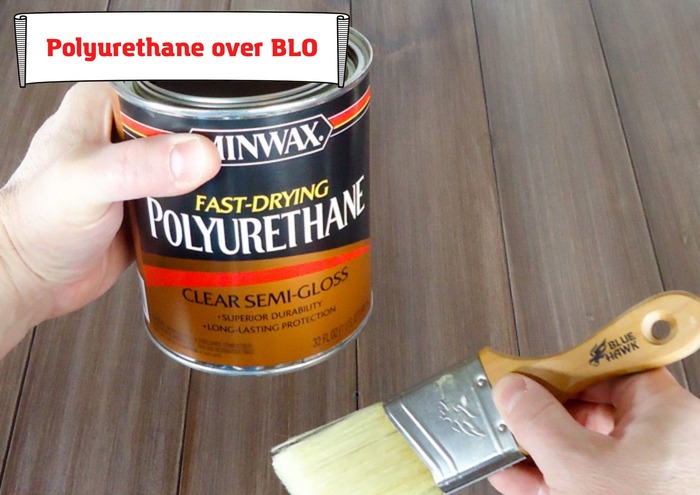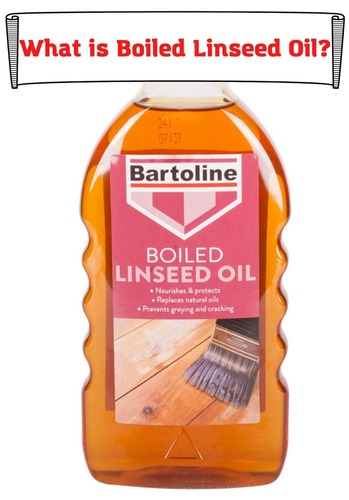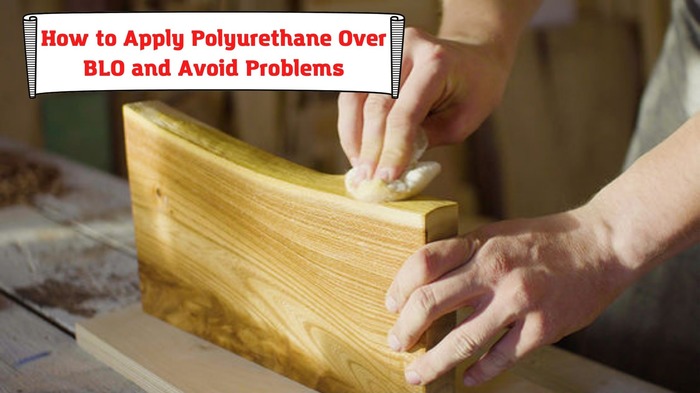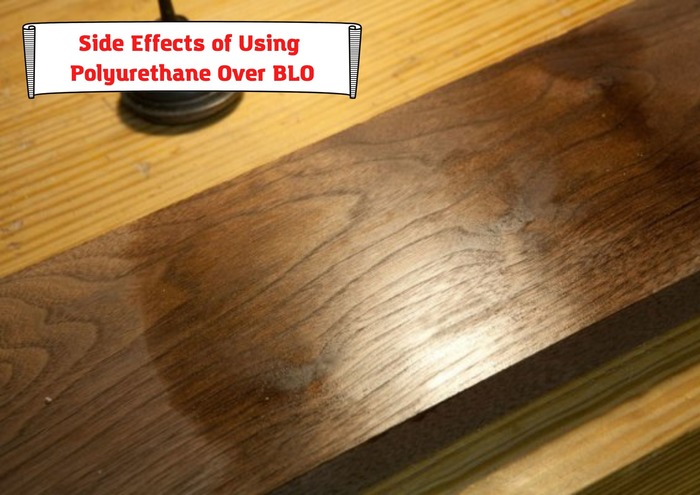
The question of how to apply polyurethane over boiled linseed oil on surfaces remains a topic for debate among woodworkers.
In this article, you will learn all about Polyurethane and Boiled Linseed Oil (BLO): their uses, benefits, among others, as well as how to apply polyurethane over BLO and avoid complications. Below are some of the highlighted topics for this discussion:
- What is Polyurethane?
- What is Boiled linseed oil?
- Can I apply polyurethane over boiled linseed oil?
- How to apply polyurethane over boiled linseed oil
- Side effects of doing so.
What is Polyurethane?
Polyurethane paint is common among woodworkers, and this is mostly due to its durability, strength, and resistant nature.
Polyurethane is water or oil-based used finish. It is used to coat wood surfaces, artworks, desks, bookcases, and picture frames. Polyurethane comes in two types: water-based plastic resin and oil-based plastic resin.
A major difference between the water and oil-based resin polyurethane is that the water-based coat dries faster than the oil-based coat. In fact, the oil-based polyurethane dries very slowly.
Polyurethane is an effective waterproof coat, and it keeps your furniture shiny and resistant to harsh weather conditions.
What is Boiled Linseed Oil?

Boiled Linseed Oil (BLO) is a common linseed oil that has been treated and heated with hot air to make the drying process faster.
Boiled linseed oil has proven to be more efficient, compared to dried linseed oil. Asides from speeding up the drying process, boiled linseed oil also prevents deterioration and fading. BLO is suitable for all kinds of wood furniture, including soft and hardwood, window frames, bunks, flooring, boats, kitchen surfaces, among others.
Boiled linseed oil, however, is not suitable on exterior oak wood.
Can I Apply Polyurethane Over Boiled Linseed Oil (BLO)?
Many people have pondered over this question countless times. The simple answer is yes. Polyurethane, when used properly, can be applied over boiled linseed oil. If polyurethane is not properly applied over boiled seed oil, it could lead to complications that may damage the wood.
Applying polyurethane over boiled linseed oil comes with a lot of benefits. Below are some of them.
It Increases Strength and Rigidity
Polyurethane paint coated over boiled linseed oil helps strengthen the wood surface. It prevents the furniture from cracking, fading, and wearing out. Generally, polyurethane oil over BLO increases the durability and lifespan of the wood.
It Provides Wood Protection Against Cracking and Leakage
Non-polyurethane surfaces tend to break and leak after a short while. But, applying polyurethane over boiled linseed oil prevents breakage, cracking, and leakage. It improves the lifespan of your wood, while still maintaining its original look and feel.
It Dries the Wood Faster
This is one of the major perks of using polyurethane over boiled linseed oil. Although applying polyurethane on linseed oil is risky, it works great on boiled linseed oil.
Usually, surfaces with BLO and polyurethane take within one week to completely dry up.
Polyurethane Adds Color to Wood Finishings
If you want to add more color to your surfaces, then you should apply polyurethane over boiling linseed oil. Polyurethane naturally brings out the beauty and preserves the aesthetics of the wood.
Similarly, for stone surfaces, a polyurethane coat brightens up stones and gives them a shiny, glazy look.
It Saves Energy and Cost
Polyurethane over Boiled Linseed Oil is durable and lasts for a long period. A polyurethane coat could last for several months and years before the effect begins to wear off. This saves the energy and cost of repainting all the time.
Polyurethane over BLO is popular in woodworks for commercial buildings, murals and paintings, doors, etc.
How to Apply Polyurethane Over BLO and Avoid Problems

Since we have already established the fact that polyurethane works well with boiled linseed oil, it is pertinent that you understand the due process of applying polyurethane over BLO to avoid problems.
Step 1- Allow the Boiled Linseed Oil (BLO) to Dry
This is an important factor to take note of before adding polyurethane to BLO. Boiled linseed oil can take a few days or weeks to completely dry up. You need to be patient and allow it to dry before taking the next step.
One of the ways to know when BLO has dried up fully is to check with your hands. If it doesn’t feel sticky anymore, then it has probably dried up completely. Alternatively, you can wait till the smell wears off completely. This might take a few weeks, but it is worth the wait.
Step 2- Sand the Surface
You should ensure that you clean the surface thoroughly before sanding. Remove every excess piece or unused material from the surface. Unclean surfaces can result in rough patches or bumpy surfaces after applying polyurethane.
Then, you can sand the surface using 320-1000 grit sandpaper. Sanding your surface will help remove unwanted particles and grains from your surfaces.
Step 3- Prepare Your Polyurethane
Polyurethane has two basic forms: water-based polyurethane, and oil-based polyurethane. Both water- and oil-based polyurethane are prepared differently before application.
For the oil-based polyurethane, you need to thin the polyurethane. The purpose of thinning an oil-based polyurethane is to make the application process seamless and to avoid brush scars. You can thin your polyurethane by adding mineral spirit to reduce the thickness.
When using water-based polyurethane, you can apply it directly. The mixture is thin and smooth enough to use without thinning.
Step 4- Application
This is a crucial stage that requires enough patience and expertise. With a bristle brush, apply the first layer of polyurethane coat over the BLO. Ensure that the coat is applied evenly around the surface.
Then, wait for a couple of hours before applying the second layer of polyurethane. The waiting period can take up to six hours for water-based polyurethane, and 24 hours for oil-based poly. This stage, as mentioned earlier, requires a lot of patience to get your desired result.
For a hard film finish, repeat the process by applying a second coat. Do it gently and evenly, and smoothen it with your bristle brush. Note that, to avoid excessive thickening, you can only apply two layers of an oil-based polyurethane coat. For water-based polyurethane, you can coat it as many times as you wish. Just make sure that each layer dries off before adding another layer.
Step 5- Polishing
This is the final stage of applying polyurethane over BLO. First, you need to inspect your work to see if you are satisfied with it. Then, you can polish the surface with a polished spray, and leave it to dry.
Side Effects of Using Polyurethane Over Boiled Linseed Oil (BLO)

Polyurethane does not have any side effects when applied over BLO. What some might call a side effect could be as a result of the wrong application or mismeasurement.
One important factor to note when applying polyurethane over BLO is that polyurethane can only be applied over BLO. Boiled linseed oil should not be applied over polyurethane.
Frequently Asked Questions
Can I Put Polyurethane Immediately After Boiled Linseed Oil?
No. You need to allow BLO to dry on surfaces before applying polyurethane. If you apply polyurethane just immediately after BLO, the mixture will create a varnish blend that may never dry.
That said, you can apply polyurethane after BLO only after the BLO has dried up totally.
Can I Use Boiled Linseed Oil As a Wood Finish?
Technically, you can. Boiled linseed oil helps to protect and strengthen wood surfaces against poor weather conditions and wearing off. However, you need more than just boiled linseed oil to strengthen it.
Boiled linseed oil is not advisable to be used alone as a wood finish. Although there are other options available, polyurethane is highly recommended to use over boiled linseed oil as a wood finish.
Summary
Polyurethane over boiled linseed oil has always been a great method to keep your wood hard, beautiful, and last for a long period. As a woodworker or someone who has an interest in painting woods, you need to understand the difference between water and oil-based polyurethane, as well as how best they can be used.
You should also exercise enough patience and follow the steps thoroughly when applying polyurethane over boiled linseed oil. If you are still unsure about what to do, you can do a test run on a small piece of wood to see the result. This process can be tried repeatedly until you have mastered the process of applying it.
Boiled linseed oil is compatible with polyurethane because it dries off faster. Ideally, it takes between 24 and 72 hours for boiled linseed oil to dry properly. Raw linseed oil takes longer to dry, and may not be very compatible with polyurethane.
Polyurethane over BLO is great and causes no complications if applied properly.
- Can You Unmix Paint: Techniques, Consequences, Alternatives - February 23, 2024
- Does Primer Need to be Mixed? Effective Primer Application - February 22, 2024
- How to Make Old Paint Usable Again: Retrieving and Preserving Paint - February 21, 2024



